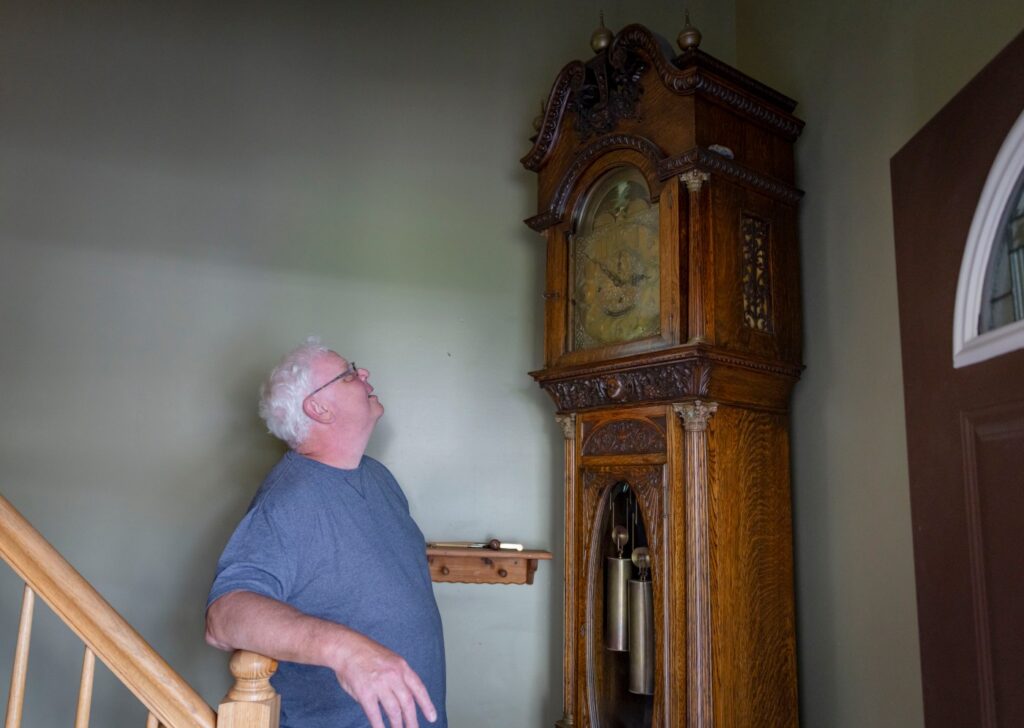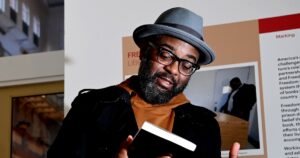
The towering grandfather clock in the foyer of Paul and Susan Monreal’s soon-to-be former home is far more than a conversation piece. It is a relic from the grand old age of worker’s saloons and packed gambling houses, intertwined with the history of one of Chicago’s most well-known families. The clock is believed to have once resided in the old South Side mansion built by James “Big Jim” O’Leary, the famous gambling boss of the early 20th-century Union Stock Yards area and the son of Catherine O’Leary, the most maligned milkwoman in city history.
Paul Monreal, a fourth-great-grandchild of Catherine and Patrick O’Leary, has cherished the intricately carved, 9-foot-tall behemoth since 1994. It has held court in the entryway of the Monreals’ split-level home in New Lenox, where they raised three children. Now empty nesters, the Monreals are downsizing and won’t be able to bring the antique clock to their new home. They are hoping someone will take it and display it for younger generations.
The Clock’s Storied Past
The clock had long been in the possession of Big Jim’s granddaughter, Geraldine O’Leary Ross, known in the family as “Doll,” at her home in Coloma, Michigan. “When I was about that big,” Paul Monreal recalled, raising his hand to his belly, “I wasn’t allowed to touch it. I know it came from the (O’Leary) mansion. And then when it came from the mansion, it went to Coloma. Outside of Doll, who had it, she never really talked about it.”
Constructed by the Tobey Furniture Co. of Chicago, a cabinet maker and dealer in fine furniture dating back to 1856, the clock’s wood carvings are similar to those found at the O’Leary mansion, including faces believed to be Catherine O’Leary. The heirloom isn’t trouble-free, Monreal says, requiring winding every month and oiling its wood once every year.
A Family’s Tragic History
Paul Monreal’s grandmother, Anna Frances O’Leary Monreal, was Big Jim’s granddaughter. She died tragically along with two of her three young children in a house fire started by a defective stove in south suburban Worth Township in 1943. Her eldest child, Edward Jr., survived and his father remarried. Edward Monreal, who was partially raised by his aunt Doll, shared stories of his lineage, but never spoke of the fire that claimed his own family.
“(Paul’s) dad never talked about (the fire),” said Susan Monreal, who grew up with her husband. While the Monreal’s home is mostly packed up, their living room was covered in O’Leary memorabilia from their branch of the family tree, from a framed piece of ash that was supposed to be from the Chicago blaze, to a leather-bound listing from the 19th century featuring all of Catherine and Patrick O’Leary’s children baptized at Holy Family Church. There are scores of newspaper clippings, keepsakes covering several generations and so many photos of relatives, the Monreals don’t know them all.
The Great Chicago Fire: A Legacy of Misunderstanding
As with other branches of the O’Leary descendants, the Monreals said they grew up with their own stories of what truly sparked the Chicago fire. The Great Chicago Fire erupted on Oct. 8, 1871, and burned a large portion of the city until it died out two days later. The fire killed hundreds and destroyed much of the central business district, which was largely constructed from wood.
“We were always told,” Susan Monreal said, “that because it was such a drought in Chicago at the time, that all the sidewalks were wood plank and guys from the saloon would come around and when they walked around they would hit their pipes ashes on the building. And that’s what we’ve always been told (about) how the Chicago fire started.”
The clock isn’t only a remembrance of Catherine O’Leary, but also of her son, James Patrick, who made a name for himself outside of the family’s dark shadow. “Big Jim O’Leary had it made,” said Susan Monreal.
Big Jim O’Leary: A Life of Adventure
Apart from the already extraordinary tale of the O’Leary clan, Jim O’Leary led a life of adventure as a main cog for the city’s infamous gambling operations at a time when gangsters battled over control of the Prohibition liquor trade. Though he grew up poor, Big Jim built a fortune running gambling and booking houses, poolrooms, an amusement park, and his famous two-story stockyards saloon, O’Leary’s, at 4187 S. Halsted St., despite near-constant hounding from police and reform-minded politicians.
“I’ve run every kind of a gambling game,” the famously honest gambler told the Tribune in November 1911. “Every time I heard of a new one, I learned it and tried it. Nobody can say that O’Leary ever ran a crooked game.”
His 33-room, 6,270-square-foot mansion at 728 W. Garfield Blvd., built in 1890 for $100,000, was reportedly built for his mother, who died five years later.
Citing the clock’s sentimental value and craftsmanship, Monreal said it didn’t occur to him to sell it, wanting younger generations to be able to appreciate it as his family has.
“We could sell it, but what’s the dollar value? What’s it worth? Who is it worth (to)?” he said. “Once you start doing that, you’re getting rid of history and after that, it’s pretty much gone. If I can get it in somewhere where people are looking at it and talk about it, if it’s taken care of, well then that’s pretty much what I’d be happy with.”
The Monreals hope that the clock, with its rich history and connection to one of Chicago’s most storied families, will find a new home where it can continue to be appreciated and remembered.







